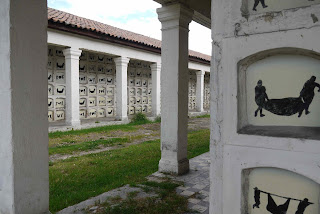 |
| The new Centro Memoria, with its reflecting pool. In the background are now-empty mausoleums, once part of the Central Cemetery. |
 The recently opened Centro Memoria, just off of 26th St. near the Central Cemetery, is heavy with symbolism of Colombia's long, tragic domestic conflicts: the somber building, whose design suggests a headstone; the building's walls, embedded with vials of earth representing tens of thousands of victims of the conflict; and the very location of the Centro, in Bogotá's Central Cemetery.
The recently opened Centro Memoria, just off of 26th St. near the Central Cemetery, is heavy with symbolism of Colombia's long, tragic domestic conflicts: the somber building, whose design suggests a headstone; the building's walls, embedded with vials of earth representing tens of thousands of victims of the conflict; and the very location of the Centro, in Bogotá's Central Cemetery.A visitor to the center can obtain a general understanding of Colombia's long, tragic and often senseless internal conflicts (as long as that visitor knows Spanish). But the displays - texts, photos and a video - don't rise much above high school level and do nothing to bring the conflict's tragedy home to visitors, much less bringing it to life.
 |
| An exhibit about the history of Colombia's guerrilla groups looks like it could have come from a high school textbook...and perhaps did. |
The Centro Memoria could fill in a gap in Bogotá's cultural and educational offerings. But I found myself wishing that its exhibits were more dynamic, more interactive.
How about victims' testimonies about their experience, both written and on video?
 |
| An exhibit about the paramilitary demobilization points out that only a tiny number of paramilitary fighters have been prosecuted judicially, despite their horrific crimes. |
What if guerrillas threaten to take away your children and turn them into child fighters? Do you abandon your town or farm for refuge in the city?
How about if paramilitaries threaten your family unless you denounce your neighbors as guerrilla sympathizers?
What if you're a soldier whose unit is expected to murder civilians to inflate guerrilla kill numbers? Do you cooperate or risk your own life and career by opposing your comrades?
 |
| The video: 'From Gaitan to La Havana.' |
What if you're a small farmer ordered by a cartel to plant drug crops? Those sorts of terrible decisions have contronted thousands or even millions of Colombians, and could bring home the drama of the nation's conflict.
 |
| Dictator Gustavo Rojas Pinilla in a scene from the video. |
 |
| The 1954 massacre of university students by the Rojas Pinilla regime. |
Neither did I see an examination of the roots of Colombia's violence: the drug trade and unequal distribution of land and wealth, which continues today. The illegal drug trade, which made 'Colombia' shorthand for violence during the 1980s and '90s and continues financing Colombia's outlawed organizations today. Would legalizing drugs, as Pres. Santos has suggested, deprive Colombia's violent groups of their fuel?
 |
| Old radios on a wall. I don't know what these were doing there. |
Colombia's current conflict involving leftist guerrillas, right-wing paramilitaries and drug cartels is only the most recent chapter in its domestic conflicts. Before that was the politically-driven La Violencia. Before that, other guerrillas and terrible civil wars.
 |
| A display details the number of people killed and displaced by the conflict. |
In fact, I was struck to find a bunch of colorful mobile exhibits about political activists assassinated in Bogotá left outdoors to be damaged by the wind and rain.
 |
| Capsules of soil imbedded in the walls represent victims of the conflict. |
The Centro Memoria is located just off of Calle 26, just west of the Cementerio Central. It opens every day except Sunday and is just a short walk from from the TransMilenio station of the same name.
 |
| An 'Act of thanksgiving' from the faithful. A candelabra in a wall from the land's time as part of the cemetery. |
 |
| The center's land includes this large, wooded field. What use will they give it? |
 |
| These mobile exhibits about political activists and leaders assasinated in Bogotá have been left outside to be damaged by the sun and wind. |
 |
| The Centro has two parking lots for cars, one of them underground, but no bicycle parking. |
Images of the now-empty mausoleums, once part of the Central Cemetery. A pair of artists stenciled images of dead being carried on stretchers, representing victims of Colombia's conflict. It was a huge project - there are some 9,000 tombs.
 |
| Empty tombs. |
By Mike Ceaser, of Bogotá Bike Tours









No comments:
Post a Comment